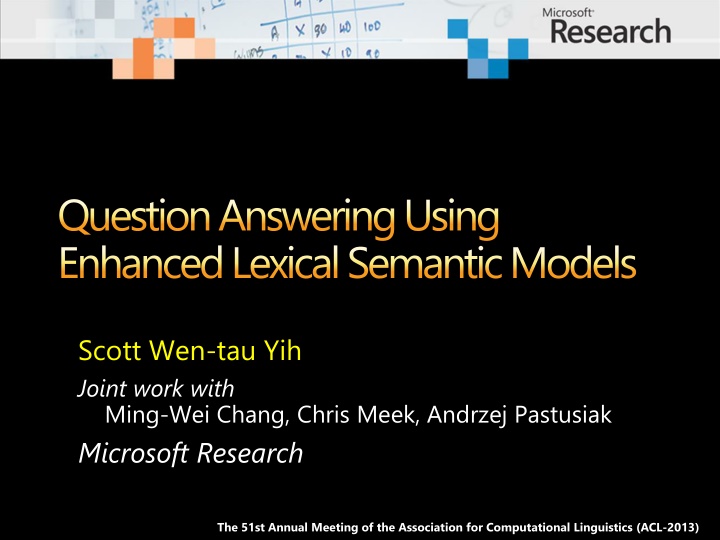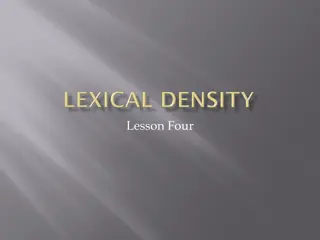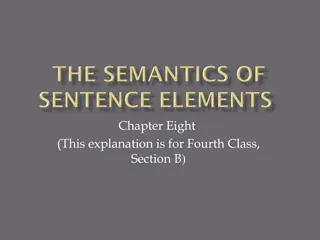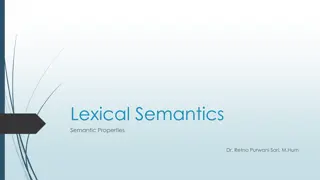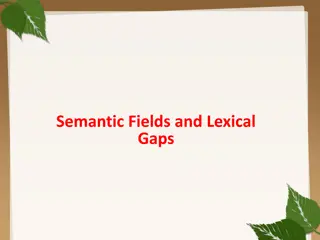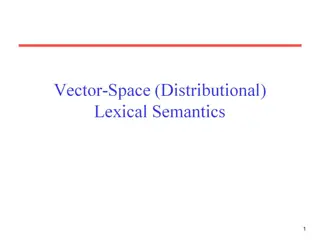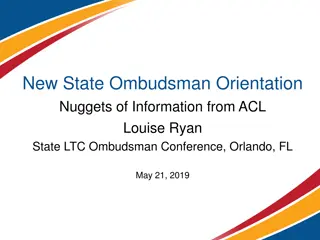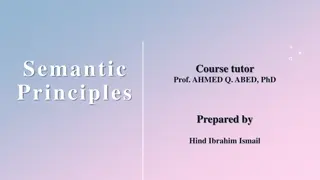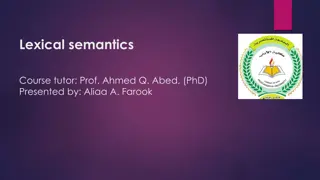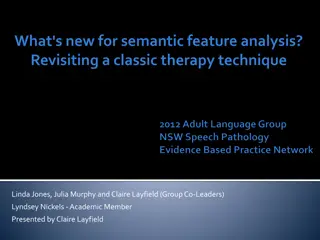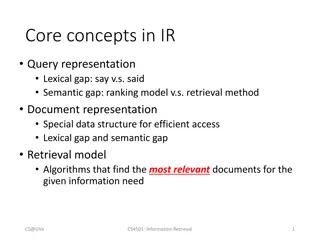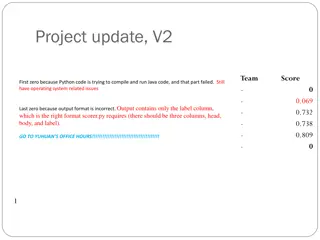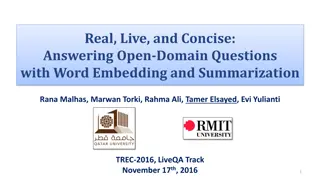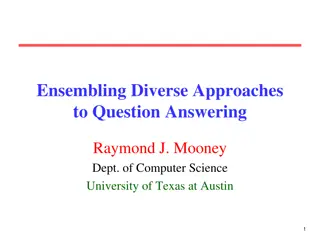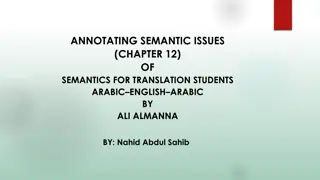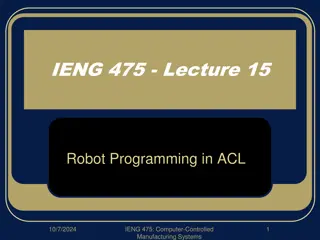Enhanced Lexical Semantic Models for Question Answering - ACL 2013 Study
Utilizing enhanced lexical semantic models, this study presents approaches for sentence selection in question answering tasks, emphasizing tree-based techniques like tree edit-distance and quasi-synchronous grammar to match dependency trees. It discusses challenges in dependency tree matching, computational complexity, and the potential of surface form matching.
Download Presentation

Please find below an Image/Link to download the presentation.
The content on the website is provided AS IS for your information and personal use only. It may not be sold, licensed, or shared on other websites without obtaining consent from the author.If you encounter any issues during the download, it is possible that the publisher has removed the file from their server.
You are allowed to download the files provided on this website for personal or commercial use, subject to the condition that they are used lawfully. All files are the property of their respective owners.
The content on the website is provided AS IS for your information and personal use only. It may not be sold, licensed, or shared on other websites without obtaining consent from the author.
E N D
Presentation Transcript
Question Answering Using Enhanced Lexical Semantic Models Scott Wen-tau Yih Joint work with Ming-Wei Chang, Chris Meek, Andrzej Pastusiak Microsoft Research The 51st Annual Meeting of the Association for Computational Linguistics (ACL-2013)
Task Answer Sentence Selection Given a factoid question, find the sentence that Contains the answer Can sufficiently support the answer Q: Who won the best actor Oscar in 1973? S1: Jack Lemmon was awarded the Best Actor Oscar for Save the Tiger (1973). S2: Academy award winner Kevin Spacey said that Jack Lemmon is remembered as always making time for others.
Lemmon was awarded the Best Supporting Actor Oscar in 1956 for Mister Roberts (1955) and the Best Actor Oscar for Save the Tiger (1973), becoming the first actor to achieve this rare double Source: Jack Lemmon -- Wikipedia Who won the best actor Oscar in 1973?
Dependency Tree Matching Approaches Tree edit-distance [Punyakanok, Roth & Yih, 2004] Represent question and sentence using their dependency trees Measure their distance by the minimal number of edit operations: change, delete & insert Quasi-synchronous grammar [Wang et al., 2007] Tree-edit CRF [Wang & Manning, 2010] Discriminative learning on tree-edit features [Heilman & Smith, 2010; Yao et al., 2013]
Issues of Dependency Tree Matching Dependency tree captures mostly syntactic relations. Tree matching is complicated. High run-time cost Computational complexity: ?(? ? ?2 ? 2)[Tai, 1997] ? and ? are the numbers of nodes respectively of trees ? and ? ? and ? are the maximum depths respectively of trees ? and ?
Match the Surface Forms Directly Q: Who won the best actor Oscar in 1973? Can matching Q & S directly perform comparably? S: Jack Lemmon was awarded the Best Actor Oscar.
Match the Surface Forms Directly Q: Who won the best actor Oscar in 1973? S: Jack Lemmon was awarded the Best Actor Oscar. Using a simple word alignment setting Link words in Q that are related to words in S Determine whether two words can be semantically associated using recently developed lexical semantic models
Main Results Investigate unstructured and structured models that incorporate rich lexical semantic information Enhanced lexical semantic models (beyond WordNet) are crucial in improving performance Simple unstructured BoW models become very competitive Outperform previous tree-matching approaches
Outline Introduction Problem definition Lexical semantic models QA matching models Experiments Conclusions
Problem Definition Supervised setting Question set: ? = ?1,?2 ,?? Each question ?? is associated with a list of labeled candidate answer sentences: ??1,??1, ??2,??2, , ???,??? Goal: Learn a classifier ? ??,???
Word Alignment View What is the fastest car in the world? The Jaguar XJ220 is the dearest, fastest and most sought after car on the planet. [Harabagiu & Moldovan, 2001] Assume that there is an underlying structure Describe which words in ? and ? can be associated Words that are semantically related
Outline Introduction Problem definition Lexical semantic models Synonymy/Antonymy Hypernymy/Hyponymy (the Is-A relation) Semantic word similarity QA matching models Experiments Conclusions
Synonymy/Antonymy Synonyms can be easily found in a thesaurus Degree of synonymy provides more information ship vs. boat Polarity Inducing LSA (PILSA) [Yih, Zweig & Platt, EMNLP-CoNLL-12] A vector space model that encodes polarity information Synonyms cluster together in this space Antonyms lie at the opposite ends of a unit sphere burning hot freezing cold
Polarity Inducing Latent Semantic Analysis [Yih, Zweig & Platt, EMNLP-CoNLL-12] Acrimony: rancor, conflict, bitterness; goodwill, affection Affection: goodwill, tenderness, fondness; acrimony, rancor Inducing polarity acrimony rancor goodwill affection Group 1: acrimony 4.73 6.01 -5.81 -4.86 Group 2: affection -3.78 -5.23 6.21 5.15 Cosine Score: + ???????? ????????
Hypernymy/Hyponymy (the Is-Arelation) Q: What color is Saturn? S: Saturn is a giant gas planet with brown and beige clouds. Q: Who wrote Moonlight Sonata? S: Ludwig van Beethoven composed the Moonlight Sonata in 1801. Issues of WordNet taxonomy Limited or skewed concept distribution (e.g., cat woman) Lack of coverage (e.g., apple company, jaguar car)
Probase[Wu et al. 2012] A KB that contains 2.7 million concepts Relations discovered by Hearst patterns from 1.68 billion Web pages Degree of relations based on frequency of term co-occurrences Evaluated on SemEval-12 Relational Similarity[Zhila et al., NAACL-HLT-2013] Y is a kind of X What is the most illustrative example word pair? X Y Probase correlates well with human annotations Spearman s rank correlation coefficient ? = 0.619 (vs. 0.233 of the previous best system) automobile wheat weather politician van bread rain senator
Semantic Word Similarity A back-off solution when the exact lexical relation is unclear Measuring Semantic Word Similarity Vector space model (VSM) Similarity score is derived by cosine Heterogeneous VSMs [Yih & Qazvinian, HLT-NAACL-2012] Wikipedia context vectors RNN language model word embedding [Mikolov et al., 2010] Clickthrough-based latent semantic model [Gao et al., SIGIR-2011]
Outline Introduction Problem definition Lexical semantic models QA matching models Bag-of-words model Learning latent structures Experiments Conclusions
Bag-of-Words Model (1/2) Word Alignment Complete bipartite matching Every word in question maps to every word in sentence What is the fastest car in the world? The Jaguar XJ220 is the dearest, fastest and most sought after car on the planet.
Bag-of-Words Model (2/2) Example ? = (?,?) is a pair of question and sentence ??= {??1,??2, ,???}, ??= {??1,??2, ,???} Given word relation functions ?1, ,??, create a 2? feature vector 1 ?? ?? ??,?? ??????,?? ?????,? = ?????,? = ?? ??,?? ????(??,??) max Learning algorithms Logistic Regression (LR) & Boosted Decision Trees (BDT)
Latent Word Alignment Structures (1/2) Issue of the bag-of-words models Unrelated parts of sentence will be paired with words in question Q: Which was the first movie that James Dean was in? S: James Dean, who began as an actor on TV dramas, didn t make his screen debut until 1951 s Fixed Bayonet.
Latent Word Alignment Structures (2/2) The latent structure: word alignment with the many-to-one constraints Each word in ? needs to be linked to a word in ?. Each word in ? can be linked to zero or more words in ?. What is the fastest car in the world? The Jaguar XJ220 is the dearest, fastest and most sought after car on the planet.
Learning Latent Word Alignment Structures LCLR Framework [Chang et al., NAACL-HLT 2010] Change the decision function from ?? (?) to argmax ?? (?, ) ? Candidate sentence ? correctly answers question ? if and only if the decision can be supported by the best alignment . Feature Design (?, ) 1 ?? (??,??) ????,?? ???, = Objective function 1 2 2 2+ ? min ? ? ?? ? ?? (?, ) s. t. ?? 1 ??max
Outline Introduction Problem definition Lexical semantic models QA matching models Experiments Dataset Evaluation metrics Results Conclusions
Dataset [Wang et al., EMNLP-CoNLL-2007] Created based on TREC QA data Manual judgment for each question/answer-sentence pair Training Q/A pairs from TREC 8-12 Clean: 5,919 manually judged Q/A pairs (100 questions) Development and Test: Q/A pairs from TREC 13 Dev: 1,374 Q/A pairs (84 questions) Test: 1,866 Q/A pairs (100 questions)
Evaluation For each question, rank the candidate sentences Sentences with more than 40 words are excluded Questions with only positive or only negative sentences are excluded (only 68 questions in the test set left) Metrics Mean Average Precision (MAP) Average Precision: area under the precision-recall curve Mean Reciprocal Rank (MRR) ???=1 ? ?=1 rank? 1 ?
Implementation Details Simple tricks that improve the models Removing stop words Features are weighted by the inverse document frequency (IDF) of the question word ????,?? ???(??) Capturing the importance of words in questions Evaluation script Previous work compared results of 68 questions to labels of 72 questions (highest MAP & MRR 0.9444) We have updated results following the same setting.
Results BDT vs. LCLR 0.75 0.709 0.707 Mean Average Precision 0.694 0.697 0.70 0.676 BDT LCLR (MAP) 0.65 0.624 0.626 0.594 0.60 0.55 I&L +WN +LS +NER&AnsType I&L: Identical Word & Lemma Match
ResultsBDT vs. LCLR 0.75 0.709 0.707 Mean Average Precision 0.694 0.697 0.70 0.676 BDT LCLR (MAP) 0.65 0.624 0.626 0.594 0.60 0.55 I&L +WN +LS +NER&AnsType WN: WordNet Syn, Ant, Hyper/Hypo
ResultsBDT vs. LCLR 0.75 0.709 0.707 Mean Average Precision 0.694 0.697 0.70 0.676 BDT LCLR (MAP) 0.65 0.624 0.626 0.594 0.60 0.55 I&L +WN +LS +NER&AnsType LS: Enhanced Lexical Semantics
ResultsBDT vs. LCLR 0.75 0.709 0.707 Mean Average Precision 0.694 0.697 0.70 0.676 BDT LCLR (MAP) 0.65 0.624 0.626 0.594 0.60 0.55 I&L +WN +LS +NER&AnsType NER&AnsType: Named Entity & Answer Type Checking
Results LCLR vs. TED-based Methods MAP MRR 0.8 0.770 0.748 0.709 0.692 0.7 0.631 0.609 0.6 0.5 LCLR* Heilman & Smith, 2010 Yao et al., 2013 *Updated numbers; different from the version in the proceedings
Limitation of Word Matching Models Three reasons/sources of errors Uncovered or inaccurate entity relations Lack of robust question analysis Need of high-level semantic representation and inference Q: In what film is Gordon Gekko the main character? S: He received a best actor Oscar in 1987 for this role as Gordon Gekko in Wall Street .
Conclusions Answer sentence selection using word alignment Leveraging enhanced lexical semantic models to find semantically related words Key findings Rich lexical semantic information improves both unstructured (BoW) and structured (LCLR) models Outperform the dependency tree matching approaches Future Work Applications in community QA, paraphrasing, textual entailment High-level semantic representations
